Thai Hoa Palace stands as a testament to the grandeur and sophistication of Vietnam’s Nguyen Dynasty. Known for its historical significance and architectural brilliance, this palace has witnessed the coronation of numerous emperors. As one of the most iconic structures within the Hue Citadel, the palace continues to captivate visitors with its intricate designs and rich cultural heritage.
Necessary information about Thai Hoa Palace
Thai Hoa Palace, or Palace of Supreme Harmony, is a central monument within the Hue Imperial City (near Perfume River). Built in 1805 the palace is an excellent example of Nguyen Dynasty architecture, featuring a combination of traditional Vietnamese and Chinese influences.
Where is Thai Hoa Palace located?
The palace is located within the Hue Imperial City, a UNESCO World Heritage Site in Hue, Vietnam (one of the best area in Vietnam). To reach the palace, visitors must first pass through the imposing Ngo Mon Gate, a grand entrance that dates back to the early 19th century. This gate, with its intricate design and historical significance, sets the tone for the grandeur that awaits inside.
After passing through Ngo Mon Gate, visitors will walk along the Trung Dao Bridge, which crosses the tranquil Thai Dich Lake. This journey offers a picturesque view of the surroundings, with the bridge serving as a symbolic pathway connecting the mundane world with the regal splendor of the imperial court. Upon crossing the bridge, the majestic facade of the palace Palace comes into view, with its ornate architecture and vibrant colors reflecting the opulence of the Nguyen Dynasty.
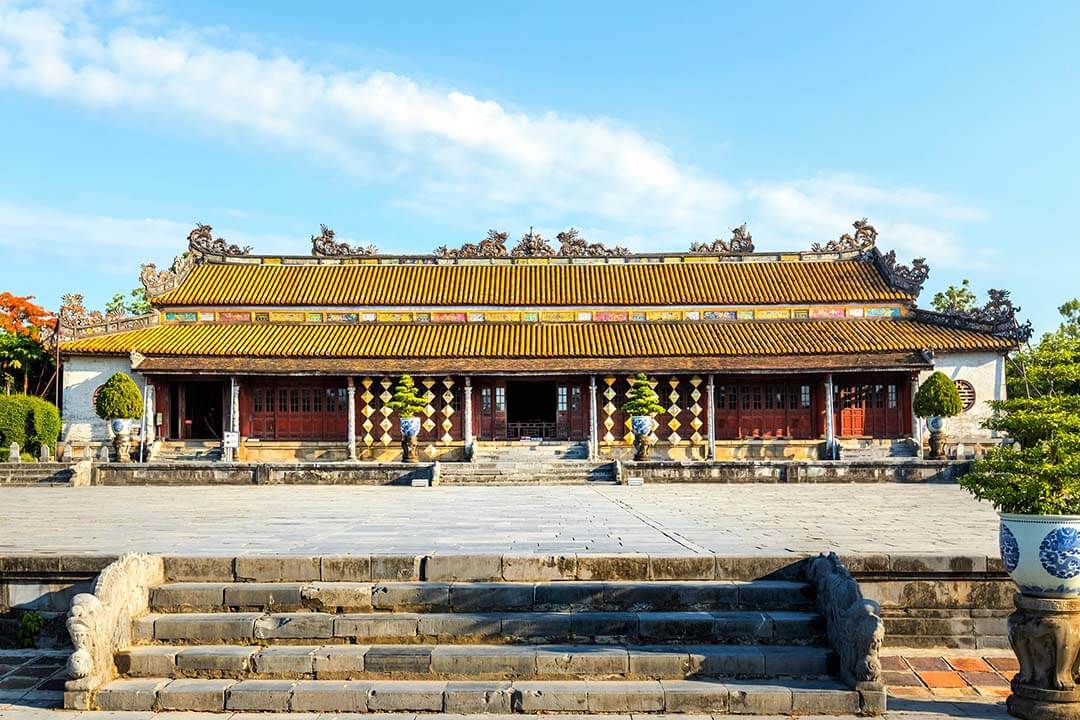
The palace’s location within the heart of the citadel underscores its importance as the center of imperial power. Surrounded by lush gardens, pavilions, and other royal buildings, the palace is a historical landmark and a peaceful retreat, offering visitors a glimpse into the grandeur of Vietnam’s royal past.
History of Thai Hoa Palace
The history of the palace is deeply intertwined with the Nguyen Dynasty, which ruled Vietnam from 1802 to 1945. The palace was constructed in 1805 under the order of Emperor Gia Long, the founder of the Nguyen Dynasty. It was strategically located in the center of the Hue Citadel, symbolizing the emperor’s supreme authority and the harmonious relationship between heaven and earth.
Over the centuries, the palace played a pivotal role in the political and cultural life of the Nguyen court. It was the site where emperors were crowned, where they held court with their mandarins, and where they received foreign dignitaries. The palace was also the venue for major royal ceremonies.
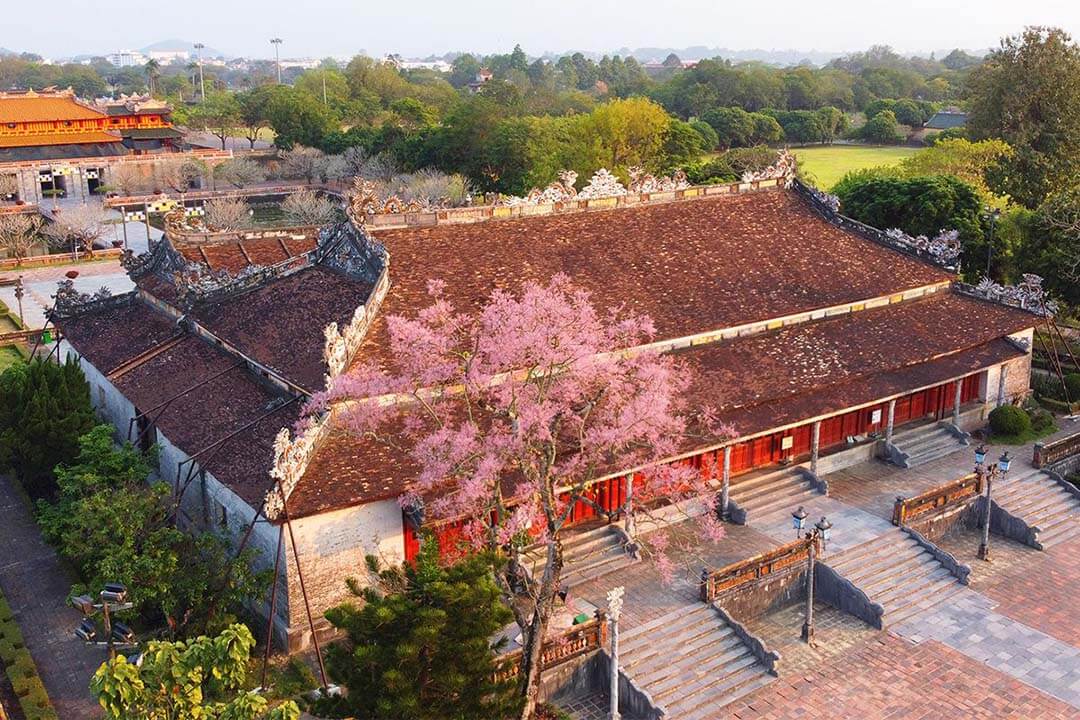
Throughout its history, the palace has undergone several renovations, particularly after sustaining damage during various conflicts, including the French colonial period and the Vietnam War. Despite these challenges, the palace has been meticulously restored to preserve its historical and architectural integrity.
Things to do in Thai Hoa Palace
Visitors have a wealth of experiences, from exploring its architectural beauty to engaging with the rich cultural history of the Nguyen Dynasty. Whether you’re a history enthusiast, an architecture lover, or simply looking to immerse yourself in Vietnam’s royal heritage.
Take lots of photos in the palace and Ngo Mon Gate
The grandeur of the palace, combined with the historical significance of Ngo Mon Gate, makes these sites perfect for photography enthusiasts. The palace’s intricate details, including the ornate roof, colorful dragon motifs, and delicate wooden carvings, offer endless opportunities for capturing stunning images. As you explore the palace, you’ll find numerous angles and perspectives that highlight the artistry of Nguyen Dynasty architecture.
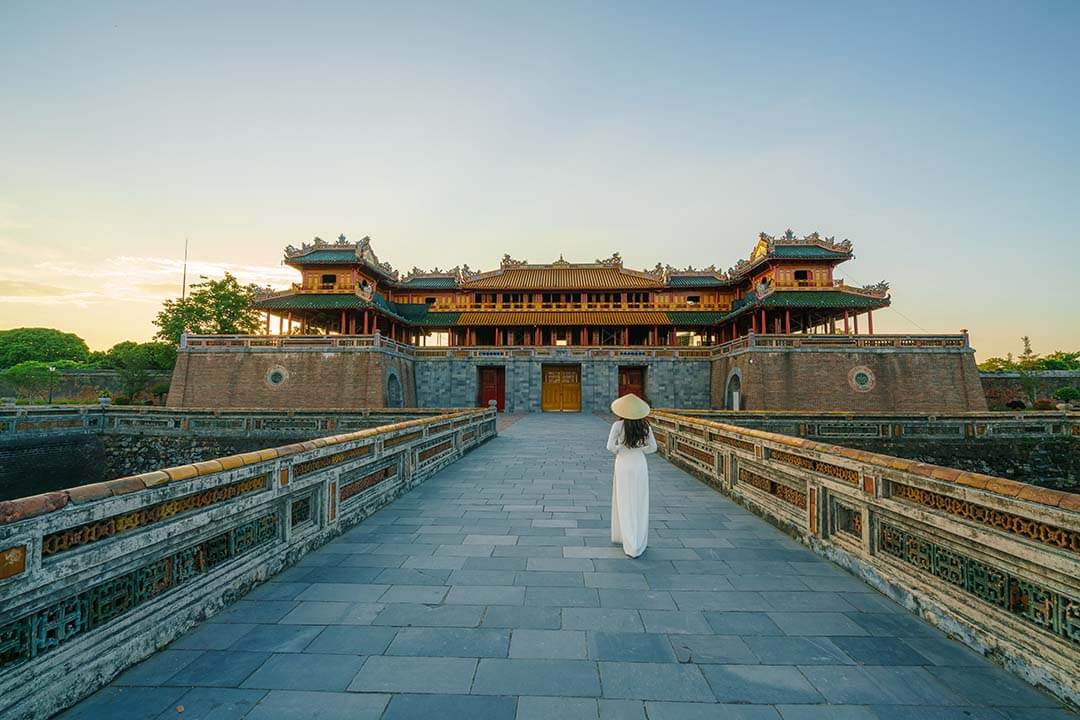
Ngo Mon Gate, with its imposing presence and historical context, also provides a striking backdrop for photographs. The gate’s multi-tiered structure, adorned with intricate decorations, stands as a symbol of imperial power and grandeur. Be sure to capture the contrast between the gate’s stately architecture and the lush greenery that surrounds it, creating a picturesque scene that reflects the beauty of Hue Imperial City.
Admire the architectural masterpiece of Thai Hoa Palace
The palace is a masterpiece of Nguyen Dynasty architecture. The palace’s main hall is supported by 80 wooden columns, each carved with intricate patterns and adorned with red lacquer and gold leaf. These columns, along with the palace’s ornate roof, create a sense of grandeur and elegance that is truly awe-inspiring.
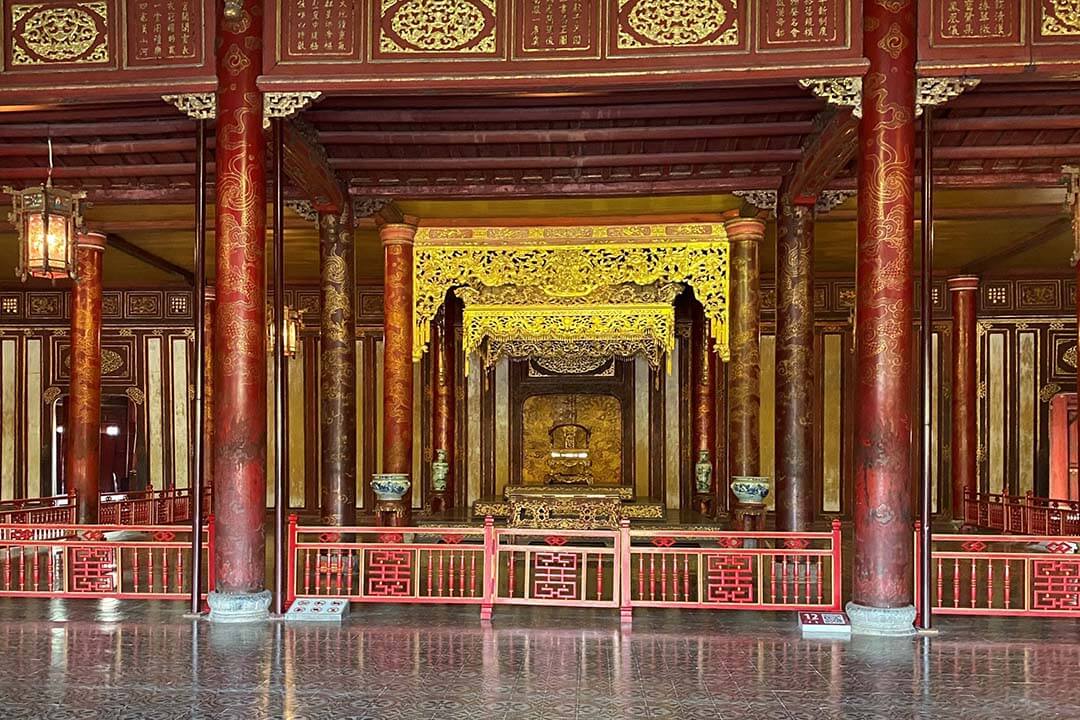
The palace’s roof is another highlight, featuring two layers of tiles with the upper layer decorated with dragon and phoenix motifs, symbolizing imperial authority and longevity. The roof’s sweeping curves and intricate details reflect the artistry and craftsmanship of the period, making it a true architectural marvel.
As you explore the palace, take the time to appreciate the fine details of its design, from the delicate carvings on the wooden beams to the vibrant colors that have been carefully preserved. Each element of the palace’s architecture tells a story, offering insights into the cultural and artistic traditions of the Nguyen Dynasty.
Experience royal life through cultural events
The palace is not just a historical site, it also serves as a venue for cultural events that bring the royal history of the Nguyen Dynasty to life. Throughout the year, the palace hosts a variety of performances, including traditional music, dance, and reenactments of royal ceremonies. These events offer visitors a unique opportunity to experience the grandeur of imperial life and gain a deeper understanding of Vietnam’s cultural heritage.
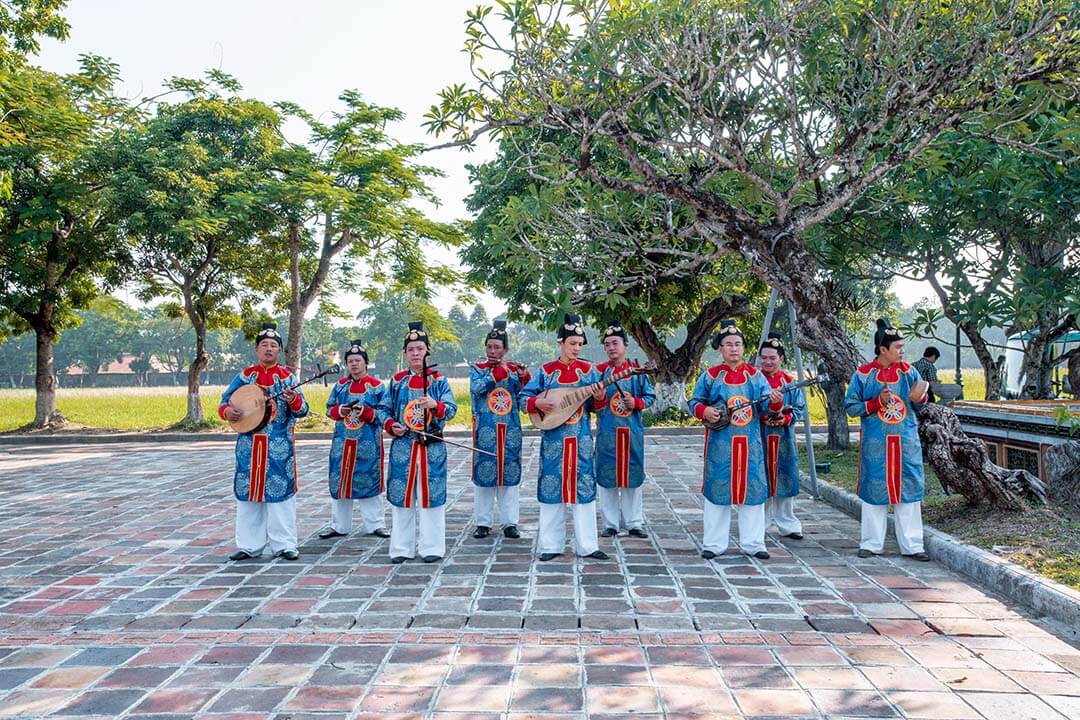
One of the most popular events is the reenactment of the emperor’s coronation, where performers dressed in traditional royal attire recreate the ceremony with great attention to detail. This event provides a fascinating glimpse into the rituals and customs of the Nguyen court, allowing visitors to step back in time and witness the splendor of Vietnam’s royal history.
Other attractions near Thai Hoa Palace
Visitors can explore several fascinating sites within Hue Imperial City. Attractions like Truong Du Pavilion, Van Minh Palace, and Can Thanh Hall offer a deeper insight into the Nguyen Dynasty’s splendor.
Truong Du Pavilion
Truong Du Pavilion, located just a short walk from the Thai Hoa Palace, serves as a tranquil retreat that offers a serene contrast to the grandeur of the palace. Once a private getaway for Nguyen emperors, it was designed for relaxation and contemplation amidst nature. The pavilion’s architecture is characterized by its simplicity and elegance, featuring wooden columns and a traditional tiled roof that seamlessly integrates with the lush gardens surrounding it.
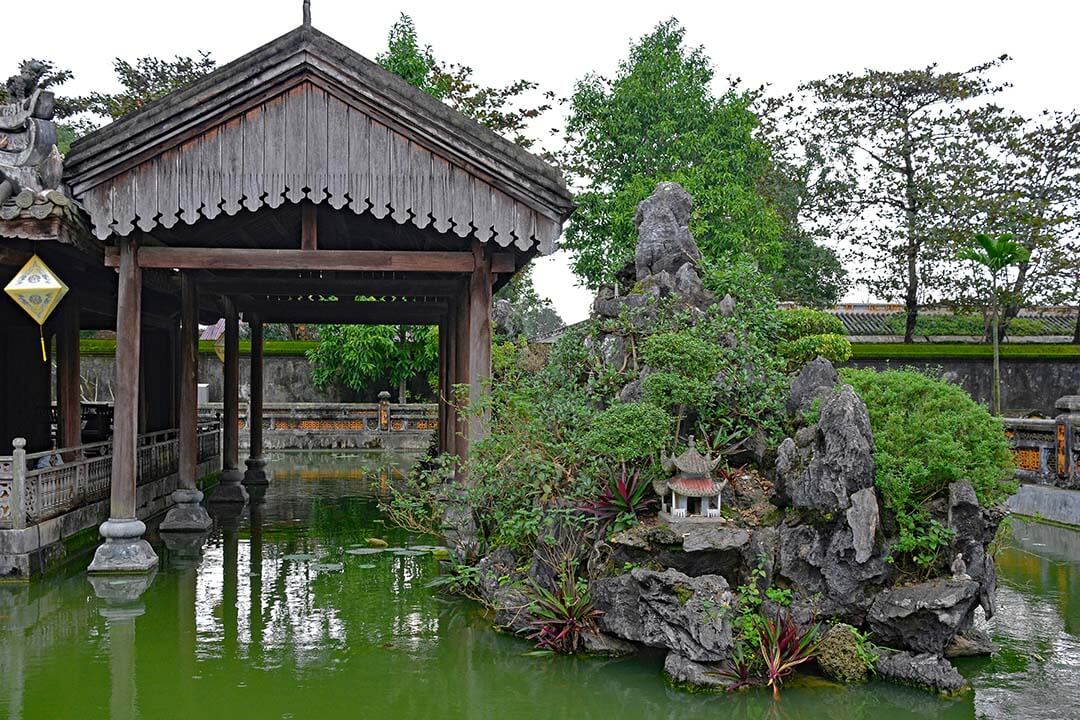
Visitors to Truong Du Pavilion can stroll through the meticulously landscaped gardens, which are designed to evoke a sense of calm and reflection. The pavilion provides panoramic views of the picturesque countryside, making it an ideal spot for a quiet respite from the city’s hustle. The combination of natural beauty and thoughtful design creates a peaceful environment where visitors can appreciate the tranquility and historical significance of this charming site.
Van Minh Palace
Van Minh Palace offers a fascinating glimpse into the lives of the high-ranking officials of the Nguyen Dynasty. Its architecture bears a strong resemblance to that of Thai Hoa Palace, characterized by elaborate wooden carvings, vibrant red lacquered columns, and a roof adorned with intricate dragon and phoenix motifs. These design elements not only highlight the artistic craftsmanship of the period but also signify the importance and prestige of the palace’s occupants.
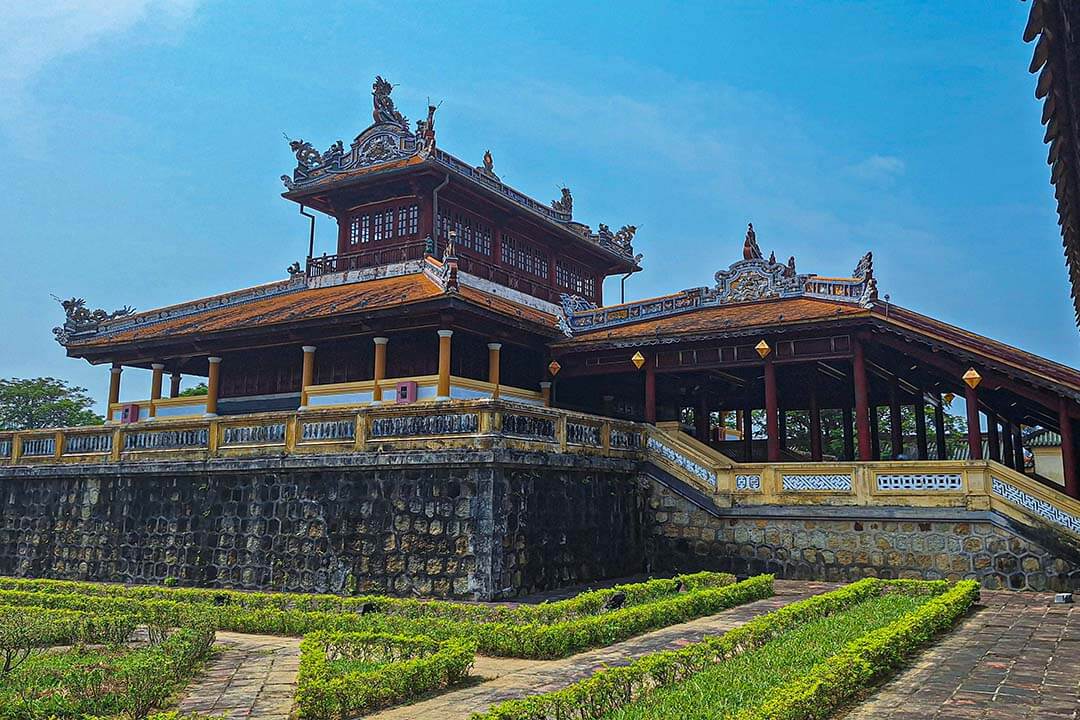
As visitors explore the palace, they will find spacious halls and chambers that showcase a wealth of traditional Vietnamese motifs and symbols. The interior is richly decorated with detailed woodwork, ornate ceiling panels, and intricately carved furniture, all of which reflect the opulence and cultural richness of the Nguyen court.
Additionally, the palace houses a collection of historical artifacts and antiques, including ceremonial objects and personal items of the mandarins, offering further insight into the daily life and customs of the era. This combination of architectural splendor and historical artifacts makes Van Minh Palace a key destination for those interested in understanding the grandeur of the Nguyen Dynasty.
Can Thanh Hall
Can Thanh Hall is a significant attraction within Hue Imperial City, renowned for its role in hosting important state ceremonies and royal gatherings. The hall’s architecture is a testament to the grandeur and solemnity of these events, featuring high ceilings supported by intricately carved wooden beams that create an imposing and majestic atmosphere. The doors and windows are elaborately decorated with detailed woodwork and traditional motifs, contributing to the hall’s stately appearance.
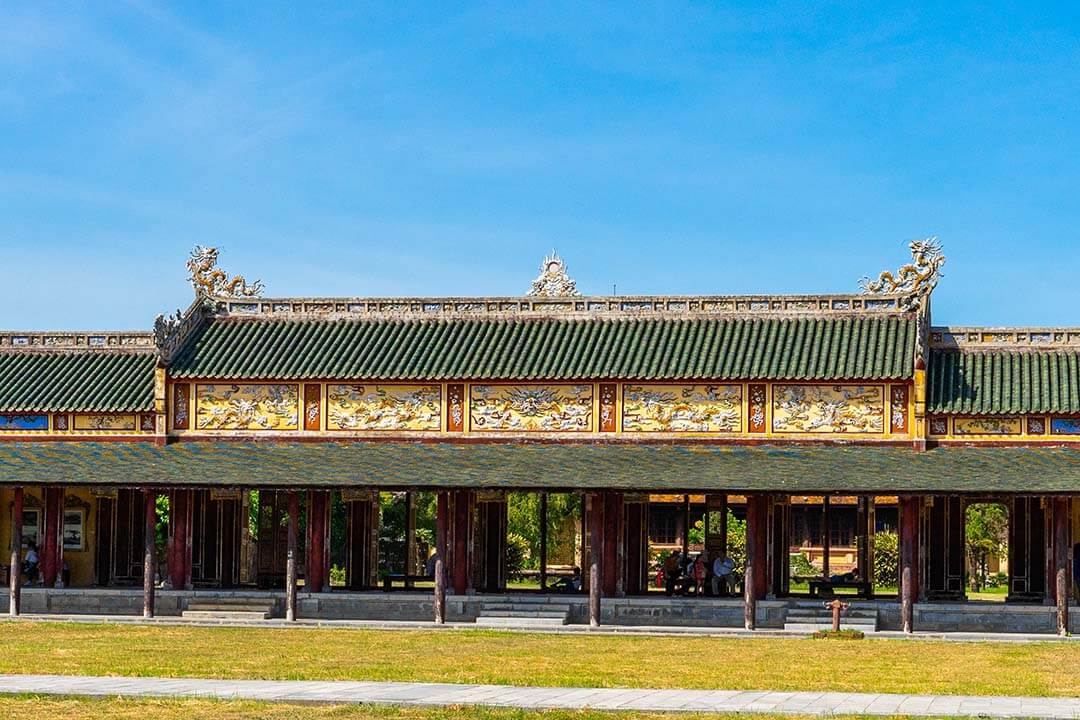
Inside Can Thanh Hall, visitors can explore its expansive and richly adorned interior, which is decorated with traditional Vietnamese artwork, including vibrant paintings and detailed sculptures. The hall also houses a collection of historical artifacts such as ceremonial objects, royal garments, and other relics that offer valuable insights into the customs, traditions, and ceremonial practices of the Nguyen Dynasty. The combination of the hall’s architectural splendor and its carefully curated collection of historical items provides a comprehensive understanding of the cultural and political significance of this grand venue within the imperial city.
Tips for a memorable visit to Hue Imperial City
When visiting Hue Imperial City and Thai Hoa Palace, following these tips will ensure a respectful and enriching experience:
- Dress politely: Given the historical and cultural importance of Hue Imperial City, dressing modestly is crucial. Choose attire that covers your shoulders and knees, such as long pants or skirts and tops with sleeves. This practice demonstrates respect for the site’s cultural heritage and aligns with local customs regarding appropriate dress for sacred and historic locations.
- Adhere to photography restrictions: While photography of the exteriors of the palaces and temples is generally allowed, many buildings within the Imperial City have restrictions on indoor photography. Pay close attention to signs and staff instructions to avoid taking photos in restricted areas. Respecting these rules helps protect the delicate interiors and ensures that all visitors can enjoy the historic ambiance.
- Respect local customs: Be mindful of local customs and behaviors when visiting religious and historical sites. Maintain a quiet demeanor and avoid loud conversations or disruptive behavior. This consideration helps create a serene environment for all visitors and respects the cultural significance of the sites.
- Plan your visit: The Imperial City is extensive, so planning your visit in advance can enhance your experience. Allocate sufficient time to explore the different areas and consider joining a guided tour to gain deeper insights into the history and significance of the sites. Check the weather and opening hours and any special events that might affect your visit.
Thai Hoa Palace is a must-visit destination for anyone interested in Vietnam’s royal history and architectural heritage. Its grand design, rich history, and cultural significance make it a key landmark in Hue Imperial City. Whether you’re exploring its ornate halls, admiring the intricate architecture, or engaging with cultural events, this palace offers a fascinating glimpse into the Nguyen Dynasty’s legacy. For more expert guidance and travel advice on visiting Hue and other remarkable destinations, follow ‘Vietnam Travel Tips‘, your trusted source for exploring Vietnam’s wonders.


